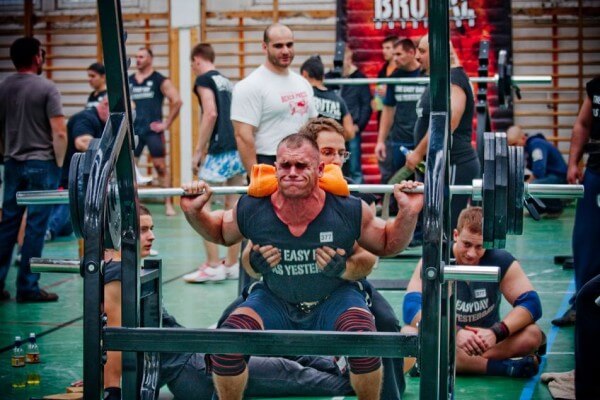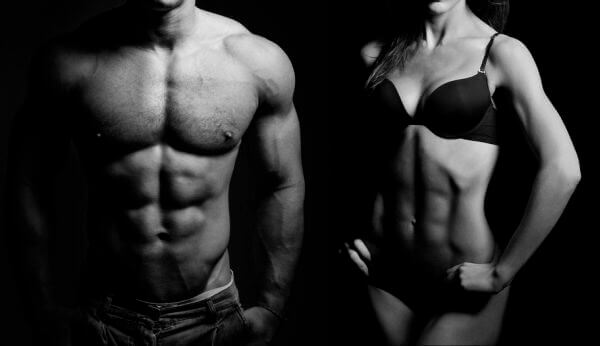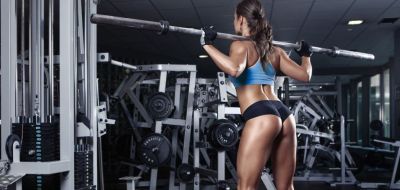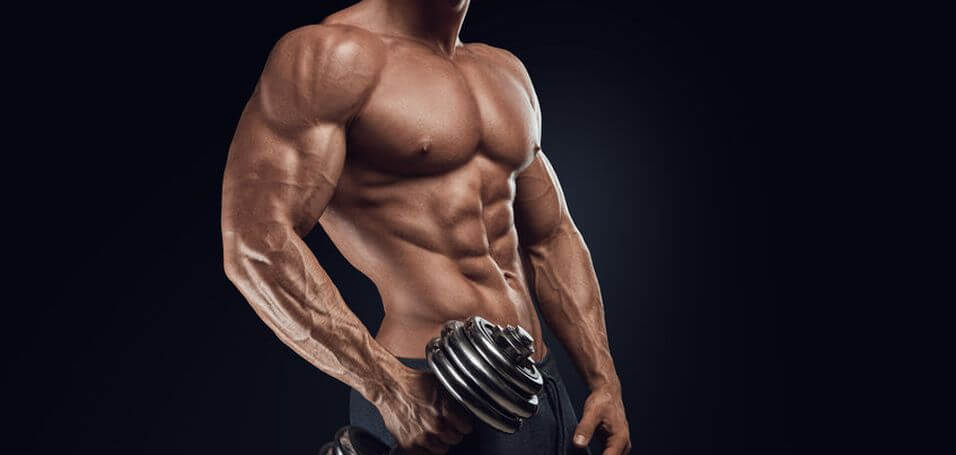Leonardo da Vinci said that simplicity is the ultimate sophistication.
I tend to agree.
In life, simple is almost always better than complex, and health, diet, and exercise are no exception.
Want to be healthy? It’s simple:
- Don’t be overweight.
- Exercise regularly.
- Don’t smoke.
- Limit your alcohol intake.
- Eat several servings of fruits and vegetables per day.
- Avoid processed meats.
Want to lose fat? That’s simple too:
- Maintain a calorie deficit.
- Eat a high-protein diet.
- Use resistance training to maintain lean mass.
- Include cardio as needed.
Want to build muscle and strength? No problem:
- Do a lot of heavy, compound weightlifting
- Progressively overload your muscles
- Don’t overtrain
- Take creatine for bonus points.
Apply this to framework to workouts and you get the ultimate simplicity in training: full-body workouts that you repeat several times per week.
Well, there’s no questioning the fact that you can get great results with full-body workouts.
They’ve been with us since the old-school strongmen like Sandow and Hackenschmidt and popular workout routines like Starting Strength and 5 x 5 continue to prove their effectiveness.
That said, I don’t believe full-body workouts are ideal for all goals and circumstances.
They fit some people’s needs and don’t fit others’ and in this article I’m going to explain why. You’re also going to learn what makes an effective full-body workout and last but not least I’m going to give you a full-body workout routine that you can get started with right away.
So let’s get started.
Table of Contents
+Would you rather listen to this article? Click the play button below!
Want to listen to more stuff like this? Check out my podcast!
What Makes a Good Full-Body Workout Routine?
The full-body workout is simple in concept–you train your entire body in one workout.
There are quite a few variables that determine its effectiveness, though. For example…
Exercise choice is key.
Some full-body workouts entail doing a lot of exercises targeting specific muscle groups individually (isolation exercises), whereas others call for fewer, compound movements that involve multiple muscle groups.
The latter is more effective than the former, which is why the most popular full-body weightlifting routines involve little more than bench pressing, military pressing, squatting, and deadlifting.
Volume and intensity are vital factors too.
Volume is the amount of sets and reps you’re doing each workout and intensity is the amount of weight you’re lifting (relative to one-rep-max).
The relationship between volume and intensity is such that when one goes up, the other must come down.
That is, increase the load of the weights you’re lifting and you’ll have to decrease the amount of reps you’re doing each workout and week. And on the flip side, increase the number of reps and you’ll have to decrease the load.
Here’s how it plays it out in actual practice:
- High-volume, low-intensity training generally yields poor results.
- Low-volume, high-intensity training is generally good for building strength but not ideal for maximizing hypertrophy.
- High-volume, high-intensity training is great for beating yourself into a pulp.
Training frequency is another element that must be managed properly.
How frequently you can and should train depends on the intensity and volume of your individual workouts. Again, you can only do so much every week before running into issues related to overtraining.
Most full-body workout programs have you do 3 workouts per week on a Mon-Weds-Fri schedule, but others handle training and rest more asymmetrically.
Some routines repeat the same workout each training day, others alternate between “A” and “B” workouts, and others still utilize three different workouts each week.
There are many workable ways to plan out training and rest and many workable types of full-body workout routines. There is, however, an overarching, non-negotiable rule that ultimately governs results:
The higher the volume and intensity of individual workouts, the less frequently you can do them.
Sure, you can squat three times per week…but you can’t do 10 heavy sets per workout.
This is why popular powerlifting programs look so austere compared to the nonsense you find in most bodybuilding magazines.
How Well Do Full-Body Workouts Work?

Research and anecdotal evidence agree that beginners can do very well with full-body workout routines.
That said, when you’re new to weightlifting, just about anything that involves picking up weights up and putting them down produces noticeable results.
The real acid test of a training routine is how well it works once the “newbie gains” run out.
What seems to work well for the first six months won’t necessarily continue to work well as you move into the “intermediate” phase of lifting.
Full-body workouts can pass this test. With the right routine (which we’ll talk about soon), an intermediate and even advanced weightlifter can continue to make progress.
That said, full-body workouts do have two considerable drawbacks that must be taken into account.
There’s Only So Much Heavy, Compound Lifting You Can Do in One Workout

One of the biggest training lessons I’ve learned over the years is the importance of emphasizing heavy, compound weightlifting. And by “heavy,” I’m talking 80%+ of your one-rep max (the 5 to 7/6 to 8 rep range and lower).
The bottom line is low-weight, high-rep training isn’t worthless to us natural weightlifters, but it should not be the focus of our efforts.
Why, then, are there are so many huge, shredded guys and gals all over the Net that don’t train heavy, you wonder?
Vitamin S really does work wonders.
You see, drugs change everything.
You can eat more food without gaining body fat. You can build a lot more muscle a lot faster. Your ability to recover is out the roof. And your body will probably respond better to the high-rep “pump” style of training.
Well, us natties are playing by a different set of rules.
If we want to continue getting bigger, we have to continue getting stronger. And if we want to continue getting stronger, we have to do a lot of heavy lifting.
That’s why my weightlifting programs for both men and women have you doing a lot of heavy lifting. I recommend that guys do most of their lifting in the 4 to 6 rep range that girls wanting to maximize muscle growth include this type of training in their routines as well.
Now, what happens when we try to do this in a full-body workout that includes compound exercises like the deadlift, squat, and bench and military press?
Well, we’ve created the hardest workout of our lives.
And no, not the good kind of hard. The “this shit is going to kill me” kind of hard.
Jokes aside, the point is this:
Heavy, compound weightlifting is extremely taxing on your entire body, not just the major muscle groups being trained.
For example, heavy deadlifting is one of the most exhausting things you can do in the gym. Heavy squatting is a very close second.
And when you try to do several sets of both and then move to several sets of heavy upper body work, your performance is going to suffer. You’re going to be gassed before the workout ends.
That is undesirable for several reasons.
First, as progressive overload is the primary driver of muscle growth, anything that impairs your ability to overload your muscles impairs muscle growth.
Well, the systemic fatigue caused by full-body workouts does just that.
For example, let’s say you start your full-body workout with heavy deadlifts. You huff and puff and get the work done and then move on to heavy bench pressing. You’ll likely find that you can’t press as much weight as you could if the bench press were your first exercise.
The same goes for the next exercise, which, let’s say, is heavy squats. Your squat is likely going to be weaker than if you started with it or did it second.
One way certain full-body programs try to work around this is to periodically change the order in which the exercises are done so all get their time in the pole position.
This is better than not rotating at all but doesn’t fully compensate for the problems posed by the accumulation of fatigue.
Second, the more drained you are, the more likely you are to abandon good form (even unwittingly).
Heavy weights and poor form is a dangerous combination. Joint problems and injuries are in the offing and these are two setbacks you want to avoid at all costs.
Nagging joint pains and strains and other soft-tissue injuries can quickly bring all progress to a halt and can take quite some time to heal.
Third, chances are you’ll start dreading your workouts because they’re just so brutally hard.
Let’s face it:
The less you like your workouts, the less likely you are to keep showing up every day.
Remember that long-term compliance is the most important part of any diet or training routine.
It doesn’t matter how theoretically impeccable a diet or training regimen is if you can’t stick to it for many months or years, depending on your goals.
And All This Makes It Hard to Optimize Weekly Volume

A well-designed workout program not only emphasizes heavy, compound weightlifting–it puts you in a “sweet spot” in terms of total weekly volume.
That is, it has you do enough reps every week to maximize muscle and strength gains.
- Do more than your body can effectively repair and recover from and you’ll wind up overtrained.
- Do less and you’ll achieve less than you could have if you had done more.
This brings us back to the subjects of volume, intensity, and frequency, which are complex, moving targets.
As you know, volume is modified by intensity but there are many other factors that come into play as well including diet, training experience, sleep hygiene, genetics, and more.
There aren’t any studies that give a definitive, one-size-fits-all answers as to how hard and how much you can train to maximize your results, and there many never be.
That said, there is enough clinical and anecdotal evidence available to derive some sensible guidelines.
Let’s first look at a large and extensive review of weightlifting studies conduced by scientists at Goteborg University.
Their research found that, when using weights in the 60 to 85% of 1RM range, optimal volume appears to be in the range of 30 to 60 reps per major muscle group per workout when 2 to 3 workouts per performed each week.
Thus, a total weekly volume of somewhere between 60 and 180 reps per major muscle group.
As you can guess, the heavier the training, the fewer reps you can and should do every week. If you were training exclusively in the 80 to 85% of 1RM range, like you do on my Bigger Leaner Stronger program, you’d want to be around 60 to 80 total reps per major muscle group per week.
If you were doing a low-weight, high-volume type of program, you’d want your weekly volume for each major muscle group to be closer to 180.
And if you were doing something in between, like with my Thinner Leaner Stronger program for women, your total weekly reps would be somewhere in between as well.
These findings also agree with another large review conducted by researchers at Arizona State University. When lighter weights are used, more sets per week is optimal. As the weights get heavier, however, total sets must come down.
So, let’s bring this back to full-body workouts.
If we have to emphasize heavy, compound weightlifting (80 to 85% of 1RM or more)…and we want to do at least 60 reps per major muscle group per week…we have a problem.
In order to do that, we have to do a full-body workout like this 3 days per week:
4 sets of deadlifts @ 85% of 1RM (4 to 6 reps)
4 sets of squats @ same
4 sets of bench press @ same
4 sets of military press @ same
That workout doesn’t just take a bit time…it takes the piss out of you. And it’s also missing calf, abs, and side- and rear-deltoid work as well, which are necessary for building an ideal physique.
So we’re back to our first problem–we can’t do enough in one workout without crushing ourselves.
“Why not do four full-body workouts per week?” you’re wondering?
Because then you’re going to run into problems with recovery.
And if you only have time for two workouts per week?
Don’t even try to hit your volume quotas unless you have a few hours and a death wish.
(That said, a full-body workout is a good choice if you can only train twice per week, and especially if you’re just looking to maintain your current physique. More on this soon.)
Is a Full-Body Workout Right For You?

As you can see, full-body workouts have their pros and cons.
- They’re a good place to start for people new to weightlifting.
- They’re good for building strength because they have you performing compound movements several times per week (and the more frequently you do a movement, the better you get at it).
- They’re good if you can only train once or twice per week.
If, however…
- you’re an experienced weightlifter,
- you’re looking to build as much muscle as possible,
- you can train three or more times per week…
…then a full-body workout routine isn’t best for you.
Instead, you’ll do better with a different workout split, which I talk about here.
The Best Full-Body Workout Routines
The best full-body workout routines are simple, which is one of their advantages. They have you do a lot of heavy, compound weightlifting and little more.
I don’t believe that men and women should do the same types of routines, though. And here’s why.
The Best Full-Body Workout for Men

If you’re like most guys, you’re more concerned with your upper body development than lower.
And if you’re like most people, your upper body is going to grow much slower than your lower body.
You see, the legs are the largest muscle group in the body and therefore are also the easiest to overload and grow.
In my experience, most guys more or less have the leg size they want in their first 1 to 2 years of weightlifting.
The upper body they want, though, takes more time and work because it involves developing smaller muscles like the biceps and triceps, shoulders, pecs, and lats.
This is why my Bigger Leaner Stronger program has you train your upper body twice per week, using heavy weights on the first day and lighter weights on the second.
And that’s how I recommend guys approach full-body workouts as well.
Here’s how I would program it:
Day 1
Deadlift: Warm up and 3 sets 4 to 6 reps (~85% of 1RM)
Bench Press: Warm up and 3 sets of 4 to 6 reps
Barbell Row: 3 sets of 4 to 6 reps
Military Press: 3 sets of 4 to 6 reps
Day 4
Squat: Warm up and 3 sets 4 to 6 reps
Front Squat: 3 sets of 4 to 6 reps
Romanian Deadlift: 3 sets of 4 to 6 reps
Bench Press: Warm up and 3 sets of 4 to 6 reps
If that looks too easy to you, don’t be fooled. Twelve sets of heavy weightlifting in one workout is harder than you think.
And as you can see, I recommend 3 days of rest in between these workouts (Mondays & Thursdays, for example).
The Best Full-Body Workout for Women

Most women have the opposite problem as men.
They want killer legs and an ass that “breaks the Internet” as quickly as possible but aren’t too concerned with upper body development.
And that’s why I recommend women approach full-body training a little differently than men.
Day 1
Deadlift: Warm up and 3 sets 4 to 6 reps if an experienced weightlifter, 8 to 10 reps if new (~75% of 1RM)
Hip Thrust: 3 sets of 4 to 6/8 to 10 reps
Bench Press: Warm up and 2 sets of 4 to 6/8 to 10 reps
Barbell Row: 2 sets of 4 to 6/8 to 10 reps
Military Press: 2 sets of 4 to 6/8 to 10 reps
Day 4
Squat: Warm up and 3 sets 4-6 reps
Front Squat: 3 sets of 4-6 reps
Romanian Deadlift: 3 sets of 4-6 reps
Hip Thrust: 3 sets of 4 to 6/8 to 10 reps
As you can see, the workouts are fundamentally the same but upper body work has been slightly scaled back to make room for hip thrusts, which are a fantastic butt builder.
The Bottom Line on Full-Body Workouts

The long story short is a well-designed full-body workout done a couple times per week is good…but not great.
Beginners can do well with this approach but once your “newbie gains” are behind you, you’re going to make better progress with an upper/lower or body-part split.
Want More Workouts?
How to Create the Ultimate Upper Chest Workout
The Best Back Exercises to Build Your Best Back Ever
The Best Shoulder Workouts for Men & Women
The 6 Absolute Best Quads Exercises You Can Do
The 6 Best Hamstring Exercises You Need to Do
The 7 Best Butt Exercises That Will Give You Glorious Glutes
The Absolute Best Biceps Workout

The Absolute Best Triceps Workout
Beyond the “Best Ab Exercises” (How to Actually Get Abs)
The Ultimate Forearm Workout
17 Bodyweight Exercises That Will Skyrocket Your Gains
What’s your take on full-body workout routines? Have anything else to share? Let me know in the comments below!
Scientific References +
- Hakkinen K, Pakarinen A, Alen M, Kauhanen H, Komi P V. Neuromuscular and hormonal adaptations in athletes to strength training in two years. J Appl Physiol. 1988;65(6):2406-2412. doi:10.1152/jappl.1988.65.6.2406
- Peterson MD, Rhea MR, Alvar BA. Applications of the dose-response for muscular strength development: A review of meta-analytic efficacy and reliability for designing training prescription. In: Journal of Strength and Conditioning Research. Vol 19. ; 2005:950-958. doi:10.1519/R-16874.1
- Wernbom M, Augustsson J, Thomeé R. The influence of frequency, intensity, volume and mode of strength training on whole muscle cross-sectional area in humans. Sport Med. 2007;37(3):225-264. doi:10.2165/00007256-200737030-00004
- Hooper DR, Szivak TK, Distefano LJ, et al. Effects of resistance training fatigue on joint biomechanics. J Strength Cond Res. 2013;27(1):146-153. doi:10.1519/JSC.0b013e31825390da
- Goldberg AL, Etlinger JD, Coldspink DF, Jableck C. Mechanism of work-induced hypertrophy of skeletal muscle. Med Sci Sports. 1975;7(4):248-261. doi:10.1249/00005768-197500740-00003
- Benton MJ, Kasper MJ, Raab SA, Waggener GT, Swan PD. Short-term effects of resistance training frequency on body composition and strength in middle-aged women. J Strength Cond Res. 2011;25(11):3142-3149. doi:10.1519/JSC.0b013e31820f505f





















